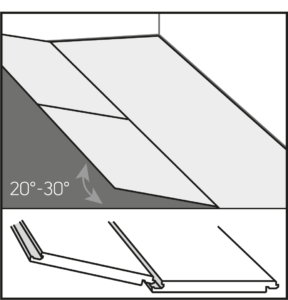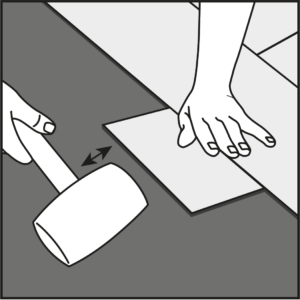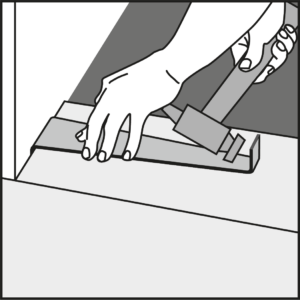It is essential that this rigid core product is installed in accordance with these instructions as well as the applicable national standards and building codes for the installation of resilient flooring at the time of installation, to ensure a quality fit. Prior to installation, please check that this product is suited to the end use application. If in doubt, please contact your supplier.
This product is a floating floor with excellent acoustic, thermal and waterproof properties made rigid to assist installation over uneven subfloor surfaces. It will not absorb, swell or be damaged by water. When installed properly and under normal use, damp mopping and topical spills cleaned up promptly will not harm the performance of the floor. This product is not suitable for installation outdoors nor in rooms that will be continually wet. It is suitable for use in traditional residential bathrooms, kitchens, laundry/utility rooms.
Install permanent fixtures prior to installation of this product, leaving a space for expansion and contraction; see below.
Please refer to section Installation procedure as to whensealant is permitted in expansion gaps. A separate underlay is not normally recommended; refer to floor covering supplier for details.
National standards and building codes
- United States and Canada: ASTM F710 / ASTM F1482
For commercial installations make sure flooring materials are removed from packaging at least 48 hours prior to installation (planks/tiles may be stacked but must be rested flat) and allowed to condition in the room where the installation is to take place. Room temperature must be kept between 65-85°F (USA) or 18-27°C (Canada).
For residential installations acclimation is generally not essential if the product temperature is already in the range 65-85°F or 18-27°C but if the product has been exposed to extreme temperatures prior to installation, acclimation is required.

Subfloor preparation must comply with ASTM F710 or ASTM F1482 and in strict accordance with these installation guidelines. Before this product may be installed, all subfloors should be solid and sound, smooth and level, clean and swept free of all debris.
Any unevenness in the subfloor should be limited to a maximum of 3/16” (5 mm) below the level for 10 ft (3 m) in any direction. Any isolated highpoints/ridges should first be removed to avoid damage to the product. Larger differences in height may need to be levelled out by filling the entire surface of the floor. Additional guidance on subfloor preparation is provided by the national standards and building codes for the installation of resilient flooring listed on page 1. If in doubt, please contact your supplier.
Moisture of the base subfloor (e.g. concrete) must be measured according to ASTM F1869 (Calcium Chloride) or ASTM F2170 (RH). The moisture limit for Rigid Core is 8lbs. (Calcium Chloride or 95% (RH).
For any subfloor showing a moisture value above these limits, a suitable damp proof membrane/moisture suppression system must be used.
NOTE: Wood subfloors should be checked and measured for moisture not to exceed 13%.
For detailed installation steps please see Installation steps.
NOTE: Rigid core/hybrid flooring should be protected from heat and/or prolonged exposure to direct sunlight as this may cause damage to your floor. See section Sunrooms / conservatories / 3 season rooms.
This product should be installed with a minimum expansion gap of 3/16” (5 mm) around the perimeter of the room and all fixed objects, including pipes. This minimum must be increased to 5/16” (8 mm) for areas larger than 1000 sq.ft./100 m² (consult your supplier for larger areas). Note: the minimum expansion gap is defined as the smallest gap between product and static fixture, that can be measured at ANY point around the perimeter.
To allow for thermal expansion, door frames should either be undercut, or an expansion gap left. Skirting/base boards should either be removed or undercut. Alternatively, a suitable edge trim should be used to cover the expansion gap. Mouldings or skirtings/base boards installed post floor installation should be fixed to the wall and NOT to the floor covering, leaving a 0.5mm clearance between these and the floor surface.
In potential wet areas where it is necessary to protect the expansion gap between fixed furniture and the flooring product from potential water exposure, a flexible acrylic or flexible low modulus neutral cure silicone sealant may be used. Sealant should not be used for the general filling of expansion gaps.
The potential wet area is to be isolated from the main field using an expansion joint system or similar at door junctions.
NOTE: As a guide we recommend a maximum net sealed area of 43 sq.ft. (4 m²). For larger areas please consult your supplier.
Where the flooring run exceeds 50 ft. (15 m) in width or length, a 5/16” (8 mm) expansion joint should be used and repeated thereafter.
This product should always be installed with staggered joints:
- Planks with a minimum 200mm between short ends
- Tiles as a ‘brick pattern (1/2 or 1/3 off-set)
Such that four corners never meet. Refer to installation Fig.5a / 5b.
Special care must be taken when installing this product in rooms that are exposed to large temperature fluctuations e.g. unheated rooms, sunrooms/conservatories or direct sun through glass doors, as incorrect use of expansion gaps can cause damage. In these cases, a minimum 3/8” (10mm) expansion gap should be used.
This product is not suited to use in saunas/similar.
Floors should be adequately protected in the vicinity of stoves/open fireplaces.
NOTE: Rigid core/hybrid flooring should be protected from heat and/or prolonged exposure to direct sunlight as this may cause damage to your floor.
- Concret/Screed (ASTM F710): Where the subfloor is uneven an appropriate smoothing compound should be selected.
- Quarry Tiles/Mosaics/Terrazzo/Ceramics: Ensure the surface is firm, dry and free of wax, oil and dust particles. Fix any loose tiles. Level any grout lines with a width and/or depth of more than 3/16” (5 mm).
- Wood Substrates (ASTM F1482): These should be solid with minimal flexibility. All loose boards must be firmly fastened, gaps filled and undulations removed. Where necessary, overlay floorboards with flooring grade plywood or similar underlay.
- Woodblock/Parquet Floors: Make sure these floors are solid and fix any loose or broken areas. Any wood in direct contact with concrete must be removed prior to Rigid Core installation.
- Metal and Painted Floors: Remove any loose paint or other finishes.
- Linoleum/Thermoplastic/Vinyl/Cork: Make sure these floors are solid and fix any loose or broken areas.
- Any existing floors installed with asphaltic tile adhesive (ATA or ‘Cutback’) must first be suitably covered/encapsulated or mechanically removed.
- Textile floor coverings (including carpet) must be removed. • Laminate or any floating floor must be removed prior to Rigid Core installation.
- Asbestos: Some older resilient tiles and adhesives can contain asbestos. Asbestos and asbestos adhesive residue must be mechanically abated by a professional abatement company prior to installing any LVT. In case of doubt contact the relevant authority for advice on removal and disposal.
- Other Floors: Consult your supplier.
Underfloor Heating: It is possible to install this product over floors incorporating underfloor heating, but these must be controlled to keep the temperature at the interface between the backing and subfloor surface at no more than 85°F or 27°C.
Electrical Underfloor Heating: Please consult manufacturer to ensure their system is compatible with this flooring. Mesh / wire systems must be bedded into a base coat of appropriate primer & levelling compound to cover the wires or mesh by consulting your underlayment supplier.
NOTE: Underfloor heating may affect moisture levels. Consult your supplier for details.
- Regularly sweep the floor to remove loose dirt or grit as these can cause fine scratches.
- For a thorough clean, a range of pH neutral cleaning products are available (‘Clean’, ‘Remove’ & ‘Refresh’). Avoid the use of regular household cleaners and bleach-based detergents. These could make the floor slippery or cause discolouration.
- Always mop up spills as soon as possible, to reduce the risk of slipping and possible staining.
- Use entrance mats to protect against grit and moisture. Ensure they are of non-staining variety (not rubberbacked) to prevent any discolouration of the floor.
- Avoid sliding or dragging furniture or other objects across the floor - use floor protector pads to prevent scratching.
- Use large castor cups or other means to protect against indentation from heavy furniture.
- Maintain room temperature between 65-85°F* or 18-27°C for optimum performance.
- Do not subject this product to standing water. This this will present a slip hazard.
- Care must be taken when using underfloor heating to avoid damage to the floor caused by localised ‘hot spots/thermal blocks’. Care must also be taken in placing rugs, and items of furniture which do not allow hot air circulation.
- The floor must be protected from excessive heat and/or prolonged exposure to direct sunlight as this may cause damage to your floor.
- Floor care guides are available from your supplier or the website. Refer to your supplier should floor tiles/planks become damaged.
For product questions, please contact the flooring dealer where you made your purchase.
Starting with a full plank/tile along the wall, calculate how many widths there are across the room. If this means there will be a row of narrow planks/tiles along the opposite wall, cut the first row accordingly. Install this product with the tongue side/cut edge facing the wall. Install 3/16” (5 mm) spacers between the plank/tile and wall (Fig. 1).

Fig. 1Install the first row, ensuring the short edges are clicked together (Fig. 2).

Fig. 2- Using a knife and straight edge, cut the last piece of the row to size making sure that there is 3/16” (5 mm) gap between the end of the row and the wall.
Start the second row by clicking the tongue into the groove holding the plank at an angle (approximately 30°), then tap the plank/tile firmly into the groove of the first row (Fig. 3).

Fig. 3Install the next plank/tile by lifting the edge of the previous plank easing the tongue and groove together on the end joint, then slide in the long side which can then be tapped into position with an “off cut of material” or tapping block. (Fig. 4a, 4b & 4c).

Fig. 4a
Fig. 4b
Fig. 4cTiles and planks should be installed “off-set” such that their four corners never meet (Fig. 5a and Fig. 5b).

Fig. 5aStone effect: Tiles should be fitted in a 'brick' pattern (off-set)

Fig. 5bWood effect: Planks should be fitted with random staggered joints with a minimum 200mm between short ends
Continue to install planks across the room until the row is complete using a hand roller to assist. Only if necessary, use a rubber mallet and an offcut of the product to gently tap the product. A pull bar can be used to pull the product together around the edges of the room (Fig. 6).

Fig. 6- Repeat steps 4 and 5 until the installation is complete.
Under door frames: If plank/tile cannot be lifted use an adapted tapping block (off-cut of material) and mallet to carefully tap the plank/tile together flat on the floor (Fig. 7).

Fig. 7- When installing around corners/convex corners, or complex profiles, mark the shape on the plank/tile and cut using a saw.
Once the floor is installed, remove the spacers; sweep the floor with a soft brush. Fix the skirting/base boards or suitable edge trim (available from your local distributor) to cover the expansion gaps. These should be attached to the wall and not the floor, such that the product remains free to expand (Fig. 8 & 9).

Fig. 8
Fig. 9